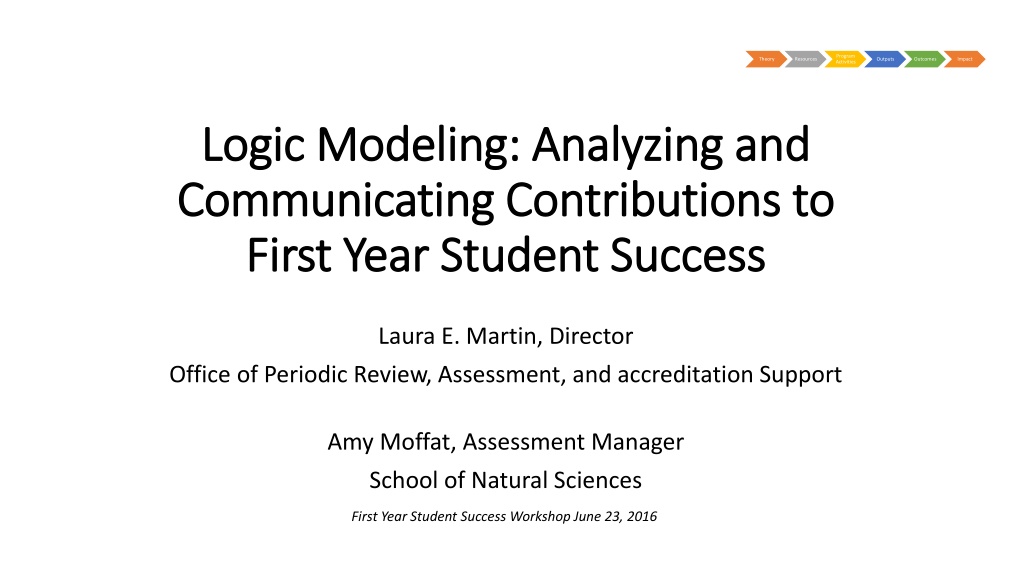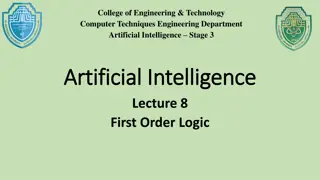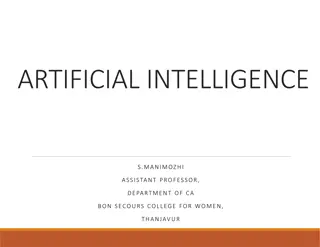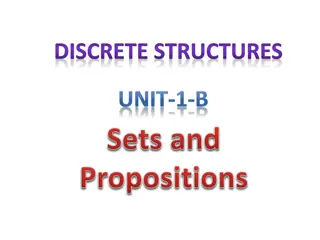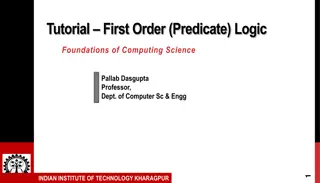Logic Modeling for First-Year Student Success: A Workshop Overview
In this workshop led by Laura E. Martin and Amy Moffat, participants learn how to utilize logic models to visualize program contributions to first-year student success. The session outcomes include initiating a logic model, proposing an assessment process, and identifying relevant resources. Premises regarding program impact and student success are discussed alongside a detailed schedule for the workshop activities.
Download Presentation

Please find below an Image/Link to download the presentation.
The content on the website is provided AS IS for your information and personal use only. It may not be sold, licensed, or shared on other websites without obtaining consent from the author. Download presentation by click this link. If you encounter any issues during the download, it is possible that the publisher has removed the file from their server.
E N D
Presentation Transcript
Program Activities Theory Resources Outputs Outcomes Impact Logic Logic Modeling: Modeling: Analyzing Communicating Contributions Communicating Contributions to First Year Student First Year Student S Success Analyzing and and to uccess Laura E. Martin, Director Office of Periodic Review, Assessment, and accreditation Support Amy Moffat, Assessment Manager School of Natural Sciences First Year Student Success Workshop June 23, 2016
Session Outcomes Session Outcomes By the conclusion, you should be able to 1. Identify one way a logic model can contribute to articulating / visualizing your program illustrating your program s contribution to first year student success 2. Initiate a logic model for your program 3. Propose an assessment process for one outcome from your logic model 4. Identify resources to help with logic modeling
Schedule 11:30 12:00 Introduction to Logic Model 12:00 1:00 Working Lunch and Logic Model Practice 1:00 1:20 Reflection and Logic Model Debrief
The Context The Context
Premise 1 Premise 1 It is unlikely that a program/intervention/experience can be expected to impact first year student success as measured by an institutional metric. 90% of first year students are in good academic standing at conclusion of first semester Mandatory Student Success Session at ASCEND Conference
Premise 1 Premise 1 It is unlikely that a program/intervention/experience can be expected to impact first year student success as measured by an institutional metric. 90% of first year students are in good academic standing at conclusion of first semester Mandatory Student Success Session at ASCEND Conference
Premise 2 Premise 2 Programs and support services typically address one facet of student journeys, and thus contribute to but are not wholly responsible for student success. Good Academic Standing
Premise 3 Student success is . an institutional effort the result of multiple complementary programs collectively addressing the needs of students (student populations) in relation to a shared intended outcome (e.g. good standing at the end of the first semester).
We are all in the boat padding (with) students toward success. What does your paddle look like?
Logic Model Designing a Paddle
Logic Model: A series of proposals to generate a desired impact. Theory/ Assump -tions Program Activities Resources Outputs Outcomes Impact Logic models are presented, not developed, in this order. Using Logic Models to Bring Together Planning, Evaluation, and Action Logic Model Development Guide. Kellogg Foundation. 2004. Retrieved from http://www.smartgivers.org/uploads/logicmodelguidepdf.pdf
Many kinds but a single example Rationale: A consistent campus approach to logic modeling facilitates Interpreting each other logic models Linking logic models to assessment Aligning unit efforts in support of a campus goal like retention
Some Logic Model Definitions for UCM Theory/ Assump -tions Program Activities Resources Outputs Outcomes Impact 1. The fundamental change occurring in an organization (i.e. UCM). E.g. High rate of good academic standing at end of the first semester.
Some Logic Model Definitions for UCM Theory/ Assump -tions Program Activities Resources Outputs Outcomes Impact 1. The fundamental change occurring in an organization (i.e. UCM). 2. Theoretical ideas, local context, and or operating principles that underpin the program/intervention. E.g. High rate of good academic standing at end of the first semester. What the literature says works. The local reasons (data, context, etc.) for thinking the literature- based solution could work here and rationale for any local modifications. Principles and/or values that guide the design of the program.
Some Logic Model Definitions for UCM Theory/ Assump -tions Program Activities Resources Outputs Outcomes Impact 2. Theoretical ideas, local context, and or operating principles that underpin the program/interven tion. 1. The fundamental change occurring in an organization (i.e. UCM). 3. The human, financial, and institutional resources needed to operate the program. E.g. High rate of good academic standing at end of the first semester.
Some Logic Model Definitions for UCM Theory/ Assump -tions Program Activities Resources Outputs Outcomes Impact 2. Theoretical ideas, local context, and or operating principles that underpin the program/interven tion. 3. The human, financial, and institutional resources needed to operate the program. 1. The fundamental change occurring in an organization (i.e. UCM). 4. The structure of the program in the form of planned activities. Events, actions, processes that constitute the program. E.g. High rate of good academic standing at end of the first semester.
Some Logic Model Definitions for UCM Theory/ Assump -tions Program Activities Resources Outputs Outcomes Impact 2. Theoretical ideas, local context, and or operating principles that underpin the program/interven tion. 3. The human, financial, and institutional resources needed to operate the program. 4. The structure of the program in the form of planned activities. Events, actions, processes that constitute the program. 1. The fundamental change occurring in an organization (i.e. UCM). 5. Direct products of program activities in the form of quantitative descriptions of how and to whom program activities are or will be delivered. E.g. frequency of activities, participant numbers, participant demographics, etc. E.g. High rate of good academic standing at end of the first semester.
Some Logic Model Definitions for UCM Theory/ Assump -tions Program Activities Resources Outputs Outcomes Impact 2. Theoretical ideas, local context, and or operating principles that underpin the program/interven tion. 3. The human, financial, and institutional resources needed to operate the program. 4. The structure of the program in the form of planned activities. Events, actions, processes that constitute the program. 5. Direct products of program activities in the form of quantitative descriptions of how and to whom program activities are or will be delivered. E.g. frequency of activities, participant numbers, participant demographics, etc. 1. The fundamental change occurring in an organization (i.e. UCM). 6. The behaviors, knowledge, skills, attitudes, etc. the program activities are designed to demonstrably engender. I.e. the learning outcomes. E.g. High rate of good academic standing at end of the first semester.
Logic Models & Assessment Is your paddle effective?
3. Provide intentional learning experiences: Curriculum and pedagogy. 4. Gather and review evidence of student learning. Assessment + Logic Model Did participants demonstrably learn what was intended? Assessment Cycle 2. Determine the evidence. What work will students do to demonstrate learning? 5. Draw conclusions about student learning achievements in the aggregate 1. Establish and make public goals for student learning. Expressed as learning outcomes, criteria and standards. 6. Act on the results to improve student achievement of learning goals Theory/ Program Activities Resources Outputs Outcomes Impact Assumptions Intended participant audience, rates, etc. Variables describing to whom and how the program is delivered in detail Did the right people participate in the right numbers? OPRAAS DRAFT
Your turn to practice In groups of three, at your table: A. Develop the logic model for a program described in Round Table 1, using the logic model template. Working from the outcomes, describe 1. The outcomes 2. The outputs 3. The program activities B. Chose one outcome and complete the assessment cycle on the back to plan how you would assess it.
Reflection Questions What is one thing you find helpful about logic models? What one question do you have about logic modeling and/or assessment?
Power of Logic Models Facilitate alignment of all elements of a program to increase likelihood of achieving intended outcomes and contributing to impact Clarify the program s contribution to institutional priorities Illustrate and communicate program s contribution to institutional goals Analyze program effectiveness with a focus on intended audience and intended outcomes Program Activities Resources Outputs Outcomes Impact Theory
Help with Logic Modeling Amy Moffat, amoffat@ucmerced.edu Penny Paxton, ppaxton@ucmerced.edu Corinne Townsend, ctownsend@ucmerced.edu Kristin Hublik, khublik@ucmerced.edu Laura Martin, lmartin@ucmerced.edu Program Activities Resources Outputs Outcomes Impact Theory
